Famous Cat Art: 15+ Paintings of Cats in Art Through the Ages
Author:
GeorgeUpdated:
12.02.2025
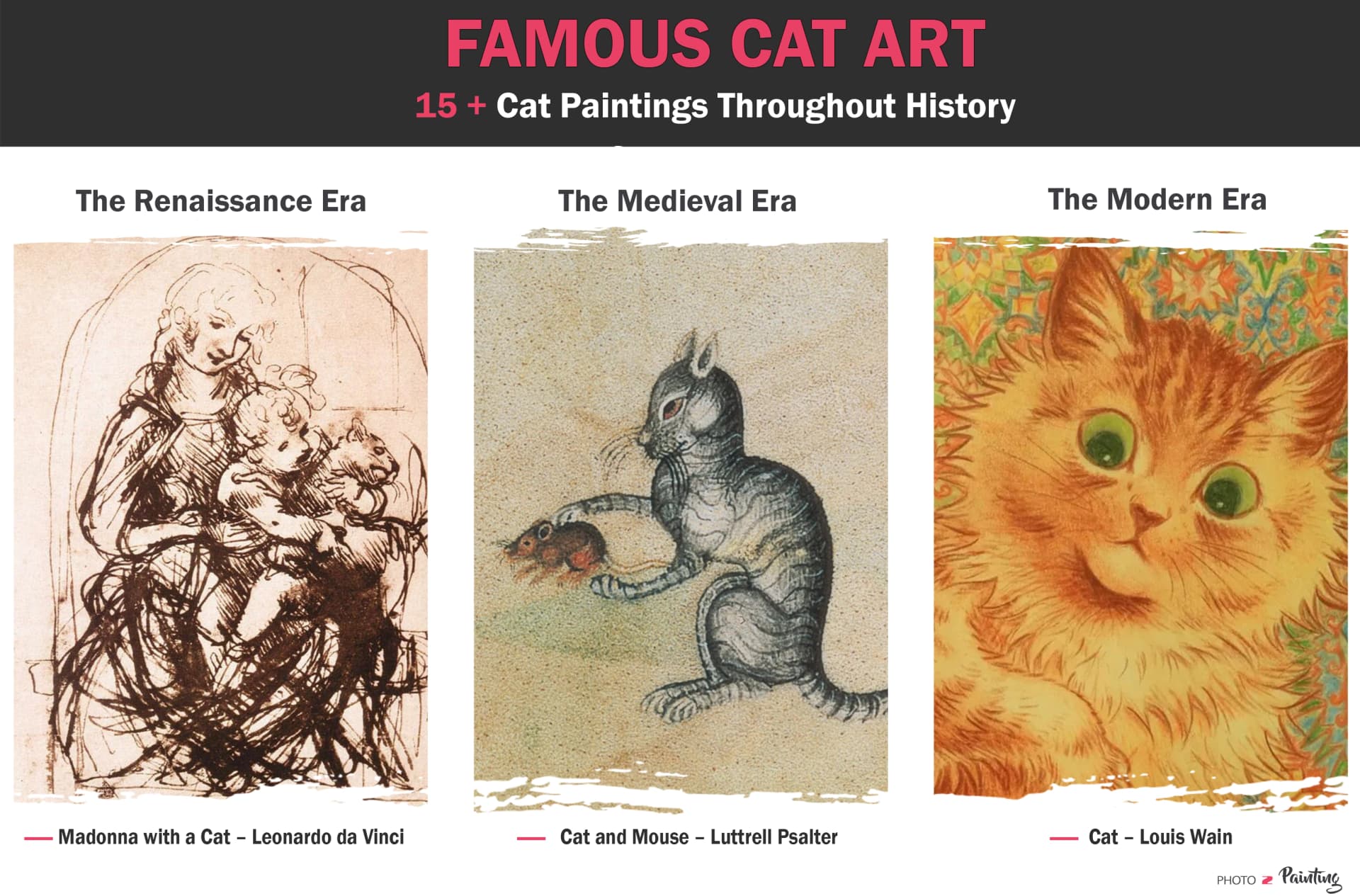

- Key Takeaways
- Cats in Ancient Art
- 1.Cats in Ancient Egypt
- 2.Cats in Ancient China
- 3.Cats in Ancient Japan
- 4.Cats in Other Ancient Civilizations
- 1.
- The Medieval Era
- 5.Mixed Symbolism
- 6.Playful and Stylized Depictions
- 7.Practical and Cultural Importance
- 5.
- The Renaissance Eras
- 8.Domestic Companions
- 9.Symbolic Meanings
- 10.A New Era for Cats
- 8.
- The Golden Age of Cat Painting
- 11.Dutch and Flemish Masters
- 12.British Masters
- 13.French Masters
- 14.The Rise of Cat Portraiture
- 11.
- Cats in Modern and Contemporary Art
- 15.Contemporary Art
- 15.
- Cats in Pop Culture and Digital Art
- 16.Cats in Film and Television
- 17.Cats in Internet Culture
- 18.Cats in Digital Art and Gaming
- 16.
- The Enduring Popularity of Cat Art
- Notable Exhibitions and Collections of Cat Art
- 19.Famous Exhibitions
- 20.Books Featuring Cat Art
- 19.
- How to Turn Your Cat’s Picture Into a Painting
Cats have always amazed people with their beauty, charm, and mystery, but their playful and graceful moments can feel so short. You see them playing, resting, or staring at you with their curious eyes, but how can you make sure those memories last forever? For hundreds of years, artists have tried to solve this by capturing the unique spirit of cats in their art.
As Leonardo da Vinci once said,
“The smallest feline is a masterpiece.”
These words show just how much cats have inspired creativity and admiration throughout history.
Cats have influenced art in ways we don’t always notice. From ancient Egyptian paintings to famous works by modern artists, cats have been shown in many different ways—sometimes as sacred animals, other times as playful pets, or even as symbols of mystery and independence. Their images not only tell us about their beauty and personality but also reveal how people have seen and valued them through the ages.
In this article, we’ll explore the fascinating history of famous cat paintings. From ancient civilizations to today’s modern works, we’ll look at how artists have celebrated the charm of cats and why these paintings continue to capture our hearts. You’ll discover how different art styles and cultures have used cats to tell stories, celebrate life, and create timeless pieces of art that people still admire today.
Key Takeaways
Cats have been celebrated in art for centuries, appearing in works from ancient Egypt to modern masterpieces.
Famous artists like Leonardo da Vinci, Pablo Picasso, and Renoir included cats in their work, showcasing their beauty, mystery, and charm.
Cats have symbolized various qualities across cultures, such as luck, independence, and protection, making them powerful artistic subjects.
Artistic styles featuring cats range from realistic portraits to abstract and surreal interpretations, highlighting their adaptability as muses.
The fascination with cats in art continues today, inspiring both traditional and digital creations that capture their unique appeal.
Cats in Ancient Art
Cats have been part of human life for thousands of years. People have always admired their beauty, grace, and unique personalities. Many cultures included cats in their art to show how important they were, whether as hunters, protectors, or symbols of good luck. One of the best examples of this is in ancient Egypt, where cats were treated like sacred animals.
Cats in Ancient Egypt
Cats were very important in ancient Egyptian society and were seen as sacred animals. They were connected to two goddesses, Bastet and Mafdet. Bastet, who was shown as a cat or a woman with a lion’s head, was the goddess of protection, fertility, and home life. Mafdet was linked to justice and the safety of the pharaoh. Because of these connections, cats were treated with great respect, and their images often appeared in Egyptian art.
Paintings, sculptures, and carvings showed cats hunting, playing, or relaxing, capturing how they behaved in real life. Cats were also valued because they protected homes from pests and were thought to bring good luck. Sometimes, they were even mummified and buried with their owners in fancy tombs. These artistic depictions highlight the central role cats played in Egyptian life, both as protectors and as sacred symbols. To truly understand their importance, let’s explore some of the most famous examples of cat-related art and artifacts from ancient Egypt, along with their fascinating details and visual representations.
The Cat of Bubastis
“The Cat of Bubastis”, illustrates a cat with an elegant collar, highlighting its role as a cherished companion. This piece also symbolizes the sacred city of Bubastis, dedicated to the worship of Bastet.
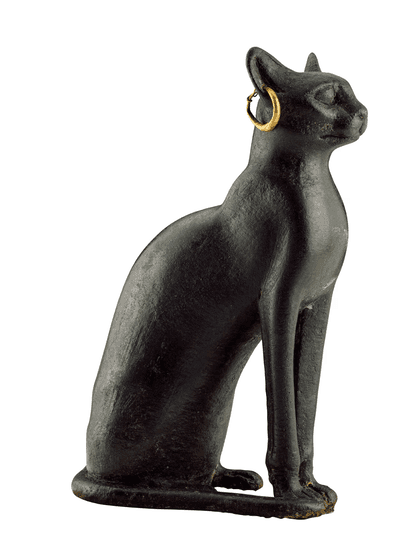
Gayer-Anderson Cat
“Gayer-Anderson Cat” is one of the most famous and beautifully preserved bronze cat statues. It represents Bastet and features intricate details, including earrings and a decorative scarab on its chest. It is currently displayed at the British Museum.
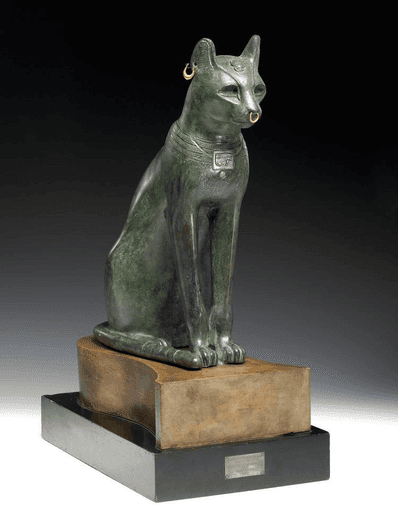
Bastet with Kittens
Bastet with Kittens is one of the most iconic representations of cats in ancient Egyptian art and religion. Bastet, often associated with protection, fertility, and motherhood, is shown here in her anthropomorphic form, blending human and feline features. The statue beautifully captures her divine significance while highlighting the cultural importance of cats in ancient Egypt.
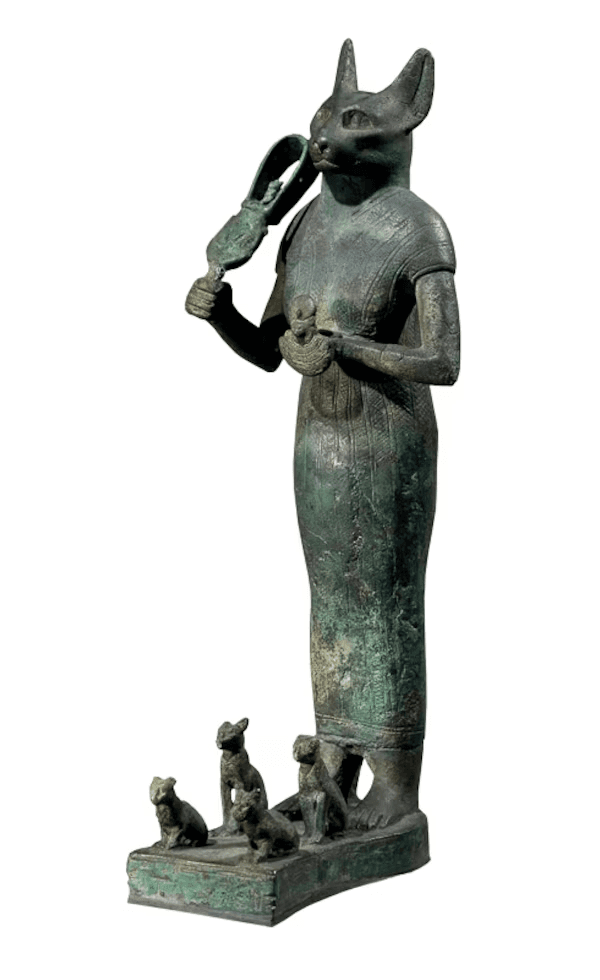
Cats in Ancient China
In ancient China, cats were an important part of daily life. They were valued for keeping pests away, which helped protect crops in farming communities. But cats weren’t just helpful—they were also seen as symbols of good luck, wealth, and safety. Their calm nature and graceful movements made them loved pets in many homes.
Even though we don’t have any artwork of cats from that time, their importance is clear from old Chinese stories and books. These records show how much people admired cats and valued their presence in their lives.
Cats in Ancient Japan
Cats first came to Japan in the 6th century, brought from China along with Buddhism. At first, they were valued for a practical reason—keeping rodents away from sacred Buddhist texts. But over time, cats became much more than helpers. They were seen as elegant and special, quickly becoming popular pets among the nobility.
The first record of a pet cat in Japan is from the 9th century, when the Emperor owned a black cat. This shows how cats were seen as important and fancy animals. Even though there aren’t any paintings of cats from this time, we know from old records and books that they were admired and had a special place in Japanese culture.
Cats in Other Ancient Civilizations
Cats were important in the cultures of the Minoans, Greeks, and Romans. They were valued for their independence, grace, and usefulness, though they were not worshipped like in Egypt. In some cases, they were connected to religious practices.
In ancient Mesopotamia, cats were likely used to control pests. Some seals and artifacts from this time show people interacting with animals that might be wildcats or early domestic cats.
We are still learning about how ancient people saw cats, and new discoveries may help us understand their role in these civilizations even better.
The Medieval Era
During the Medieval period, cats were viewed in both positive and negative ways, and this was reflected in the art of the time. While some saw them as symbols of evil, others admired their grace and practical usefulness. Despite these mixed feelings, cats often appeared in medieval artwork. These representations show how people of that time saw them as both fascinating and important.
Mixed Symbolism
Cats had a double-edged reputation in the Middle Ages. They were sometimes linked to witchcraft and the devil, especially because of their nocturnal habits and mysterious nature. This led to their portrayal as demonic creatures in some religious art. However, they were also seen as symbols of good fortune, protection, and domesticity, often shown as companions to saints or as guardians of homes.
Playful and Stylized Depictions
Medieval artists often portrayed cats in playful and whimsical ways. They frequently appeared in the margins of illuminated manuscripts, adding humor and charm to sacred texts. Artists sometimes exaggerated feline features, creating unique and stylized representations that reflected the creativity of the period.
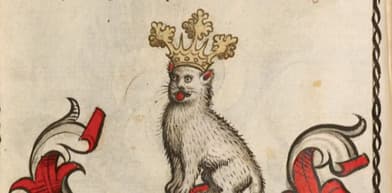
Practical and Cultural Importance
Cats played a practical role in medieval life by controlling pests and protecting food supplies. Their usefulness made them valuable to many households, and their portrayal in art highlights how people admired them for both their practical and symbolic roles.
Cats in the Middle Ages were shown in many different ways through art. From funny drawings in the margins of books to important symbols in religious images, these artworks show how people felt about cats at the time. Let’s look at some examples that show the unique roles and meanings cats had during this period.
Cat and Mouse
The "Cat and Mouse" illustration from the Luttrell Psalter is a playful and humorous example of medieval art. This 14th-century manuscript, known for its detailed and lively marginalia, features a cat chasing a mouse, a scene that reflects everyday life and the practical role of cats as pest controllers. The exaggerated features of the cat, like its oversized body and expressive face, add charm and humor, showing how medieval artists often added creativity and fun to sacred texts. This artwork highlights the dual role of cats as both useful animals and sources of amusement in medieval society.
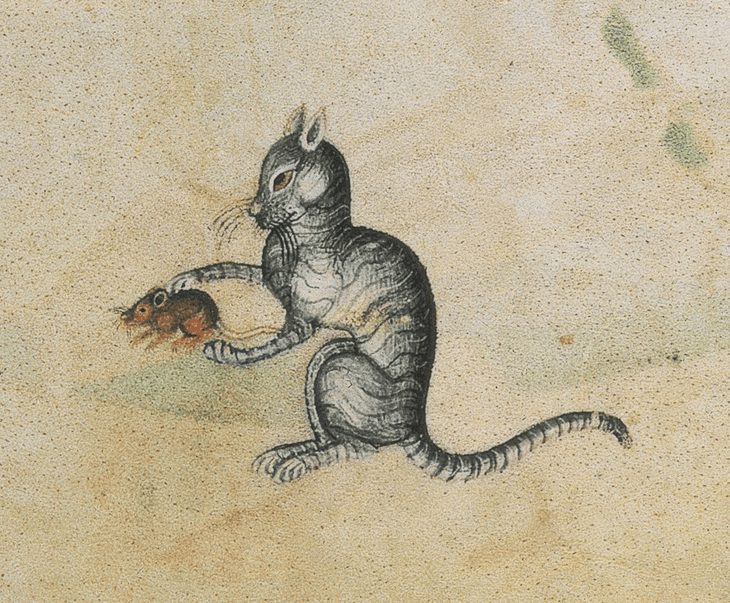
A Donkey Playing a Flute and a Cat Playing a Tabor
The "A Donkey Playing a Flute and a Cat Playing a Tabor" illustration from the Queen Mary Psalter is a great example of medieval humor. It shows a donkey playing a flute and a cat playing a small drum, creating a funny and unexpected scene. The donkey symbolizes foolishness, while the cat, known for its independence, adds a playful touch. These types of drawings, called drolleries, were common in medieval books and added humor to serious religious texts. They reflect the creativity and imagination of medieval artists, bringing animals to life in fun and surprising ways.
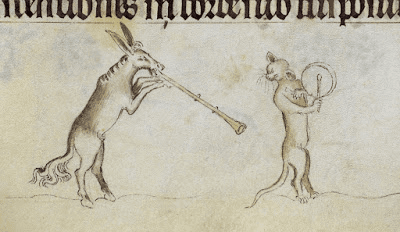
The Bodley Bestiary
The illustration from the Bodley Bestiary shows a cat’s hunting nature, carrying a captured mouse in its paws. Another cat stands nearby, pulling at a birdcage, while a third rests curled up. The scene highlights how people in the Middle Ages saw cats as skilled hunters but also mysterious creatures.
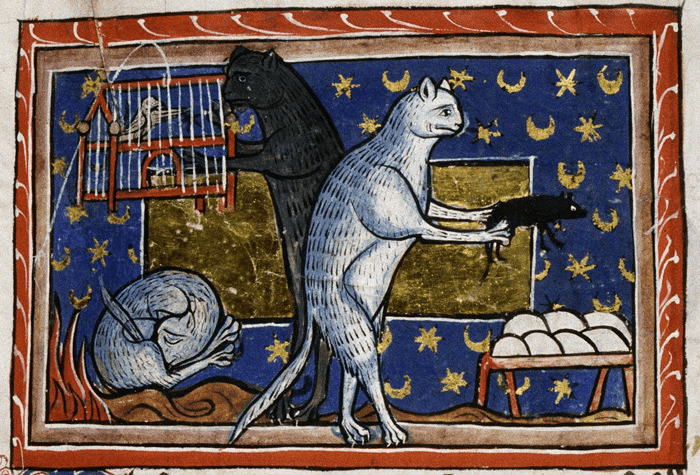
The Renaissance Eras
The Renaissance was a time of change and discovery, not just for people but for how they viewed the world around them. Artists during this period focused on realism and celebrated everyday life, including the animals that were part of it. Cats, with their unique personalities and roles in homes, became a popular subject in Renaissance art. Whether as symbols of mystery or as beloved companions, cats were painted with great care and detail, reflecting their growing importance in society.
Domestic Companions
Renaissance artists painted cats with great detail, showing their fur, behaviors, and unique looks. Cats were often included in scenes of everyday life, showing them as loved pets in homes. They also appeared in still-life paintings, where they added energy and life to the pictures.
Symbolic Meanings
Cats had different meanings in Renaissance art. They were sometimes seen as symbols of independence, mystery, and even female beauty. In some cultures, cats were also thought to bring good luck and protect homes, which was shown in their artwork.
A New Era for Cats
The Renaissance changed how artists showed cats. They began to paint them more realistically and with care. These paintings showed how cats became important as part of families and everyday life.
Madonna with a Cat
The "Madonna with a Cat" is a sketch by Leonardo da Vinci. It shows the Virgin Mary holding baby Jesus while a playful cat joins them. The drawing feels warm and full of life, showing a close bond between the figures.
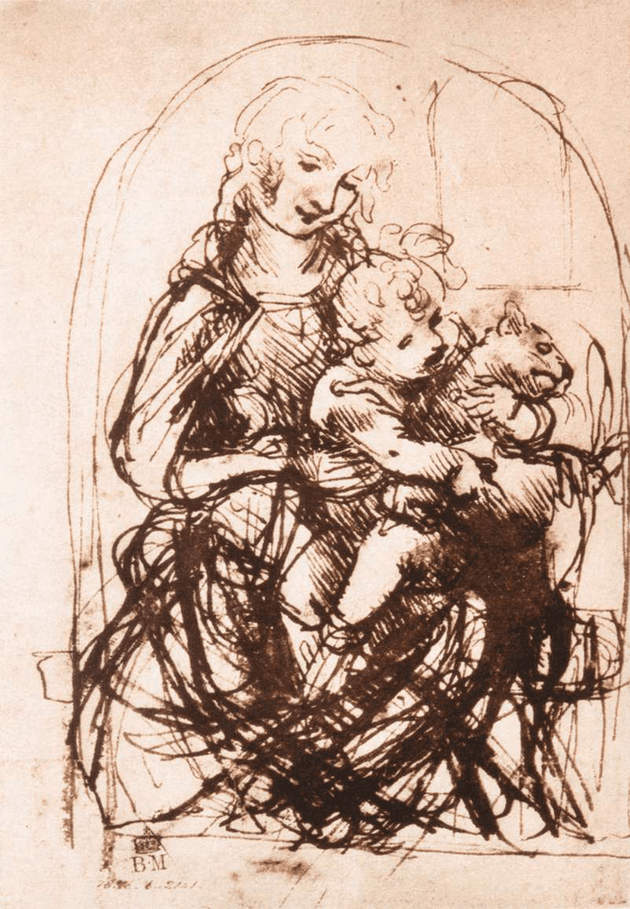
Leonardo’s love for nature is clear in how he sketched the cat’s pose and expression. Adding the cat makes the scene feel familiar and charming. Even though the sketch is unfinished, it shows Leonardo’s talent for capturing both people and animals.
A Sketch of Cats
Leonardo da Vinci’s "Sketch of Cats" is a series of drawings that shows his careful study of cats. The sketches capture cats in different poses, from playful movements to moments of rest.
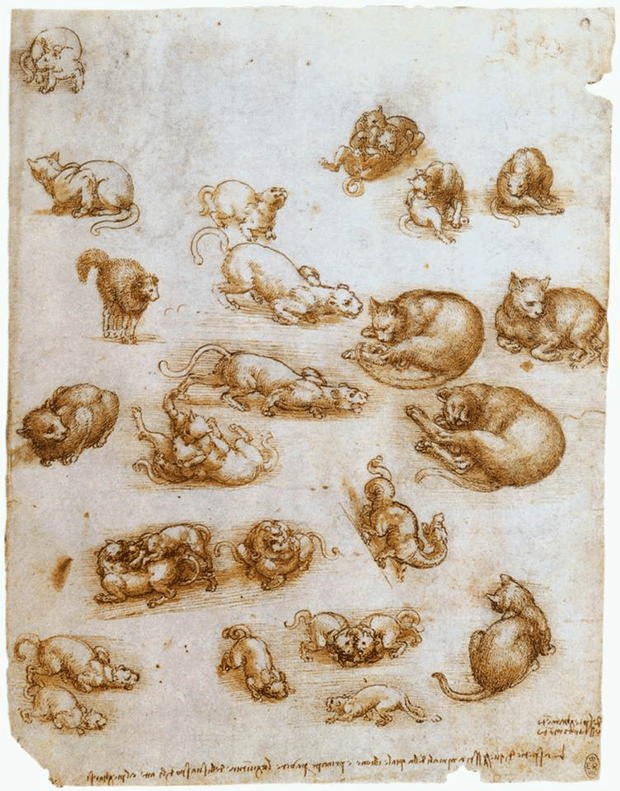
Leonardo’s attention to detail is clear in the way he drew their graceful bodies and curious expressions.
The Golden Age of Cat Painting
The 17th and 18th centuries marked the Golden Age of cat paintings, as artists across Europe celebrated the beauty, grace, and intelligence of these animals. This period saw a remarkable increase in the number of cat portraits and their inclusion in a variety of artistic styles, from genre scenes to still-life compositions. Cats were no longer just symbolic; they were painted as cherished companions and admired for their elegance and personality.
Dutch and Flemish Masters
Artists in the Netherlands highlighted cats as an integral part of everyday life.
Jan Steen
Jan Steen is known for his lively genre paintings, Steen often included cats in household scenes. His cats were painted with great realism, showing them as valued members of the home.
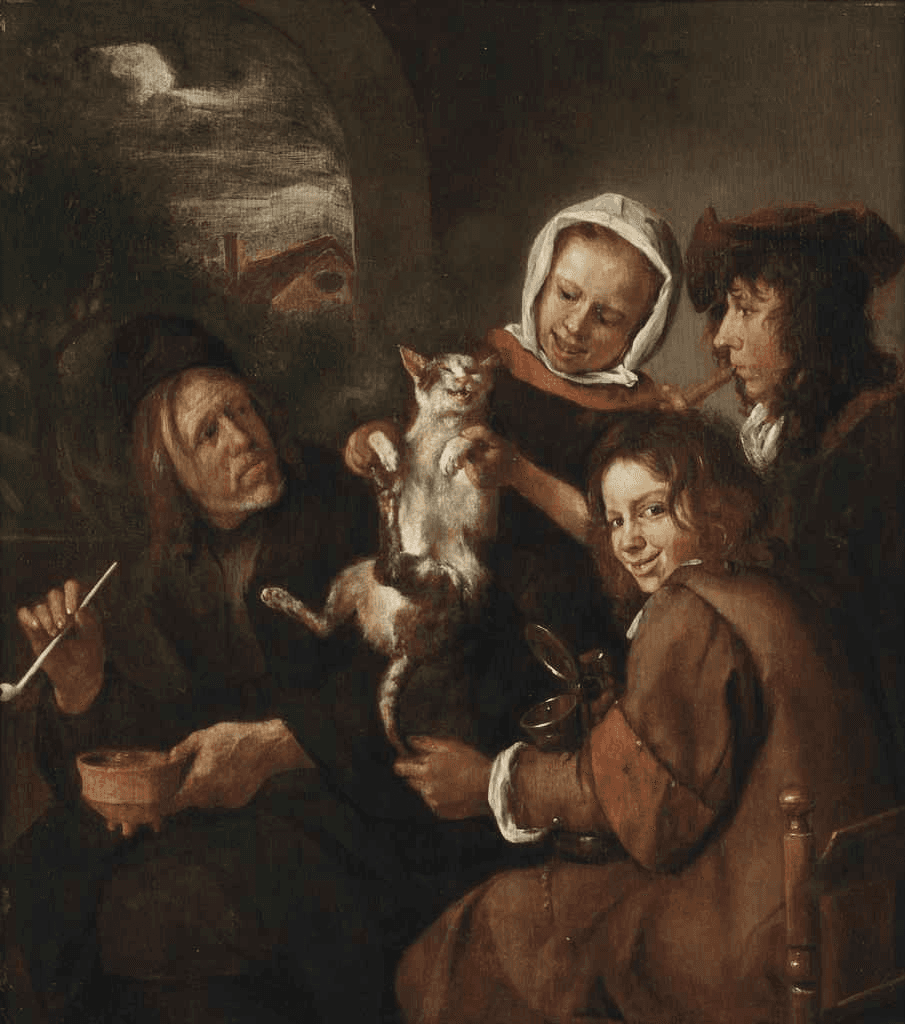
Gabriel Metsu
Metsu's domestic interior scenes frequently featured cats, adding warmth and intimacy to his compositions and showcasing their place in family life.
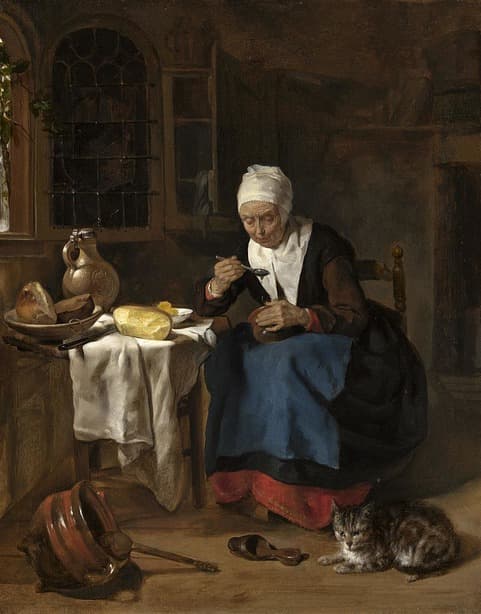
British Masters
British artists used cats as both humorous and elegant subjects.
William Hogarth
William Hogarth is known for his satirical works. He often included cats as symbols of domestic life, representing the comfort and chaos of home. At times, he used cats as humorous elements, adding mischief and personality to his detailed scenes.
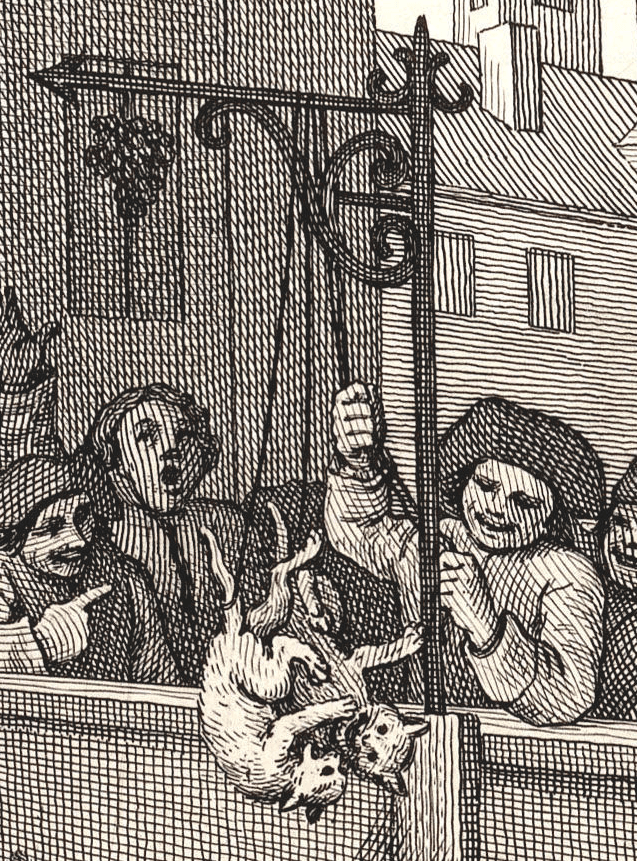
George Stubbs
Famous for painting horses, George Stubbs also depicted cats with incredible skill. He highlighted their elegance, graceful movements, and expressive features, capturing their unique charm in his art.
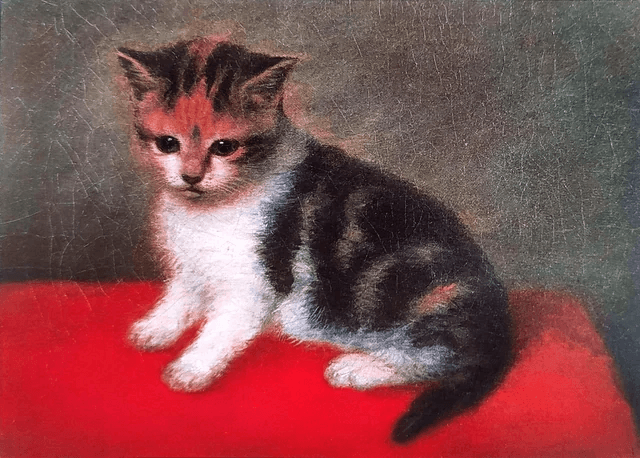
French Masters
French painters portrayed cats with classical grace and precision, often highlighting their elegance and charm in detailed still-life compositions or domestic scenes.
Jean-Baptiste Oudry
Jean-Baptiste Oudry's still-life paintings often included cats, showing their natural grace and charm. He painted them in a detailed and elegant style, making them stand out in his work. Cats in his paintings were not just part of the background—they added life and warmth to the scene. Oudry focused on their soft fur, calm poses, and quiet beauty, showing how special and dignified they were.
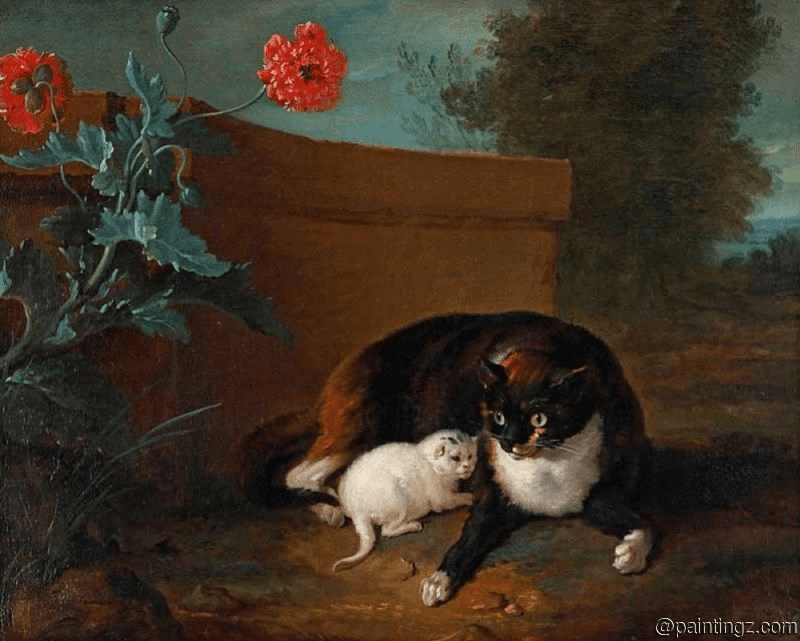
Jean-Honoré Fragonard
Jean-Honoré Fragonard, known for his fun and lively paintings, often included cats in his art. He used them to bring warmth and playfulness to his scenes. Cats in his paintings are often shown playing or interacting with people, adding charm and life to his work. Fragonard’s art shows the joy and energy that cats bring, making them an important part of his cheerful style.
The Rise of Cat Portraiture
This time also saw the rise of cat portraits, where artists made cats the main focus of their work. These paintings showed each cat’s personality and unique features, like their playful eyes or special fur patterns. They reflected the strong bond between people and their cats, showing not just their beauty but also the love and connection they shared. These portraits helped make cats more than just pets—they became stars in the world of art.
The Golden Age of cat paintings not only celebrated the charm of these animals but also established a lasting tradition that continues to inspire artists to this day.
Cats in Modern and Contemporary Art
Cats have continued to inspire artists in modern and contemporary times, often symbolizing mystery, independence, and domesticity. From whimsical portrayals to bold abstractions, cats have been explored in countless artistic styles, reflecting their timeless charm and enigmatic nature.
Louis Wain
Louis Wain is known for his whimsical and anthropomorphic depictions. Louis Wain's cats, with their large expressive eyes and playful charm, have delighted audiences for generations.
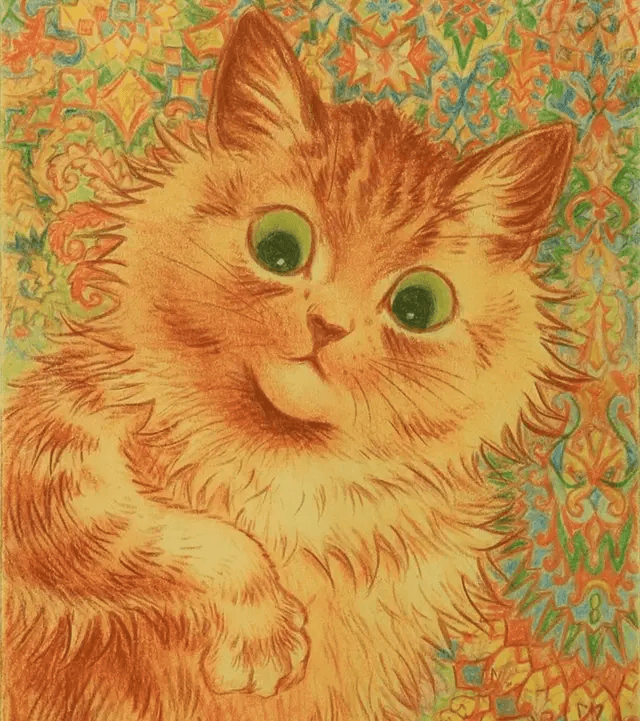
Pablo Picasso
The famous Cubist artist included cats in his works, capturing their essence through bold lines and abstract forms. His unique style reimagined the feline shape, focusing on their grace, independence, and mysterious nature. Picasso often used simplified shapes and striking contrasts to portray their personalities, blending their natural movements with the fragmented, dynamic style of Cubism. These depictions showed his ability to transform everyday subjects, like cats, into powerful symbols of creativity and emotion in modern art.
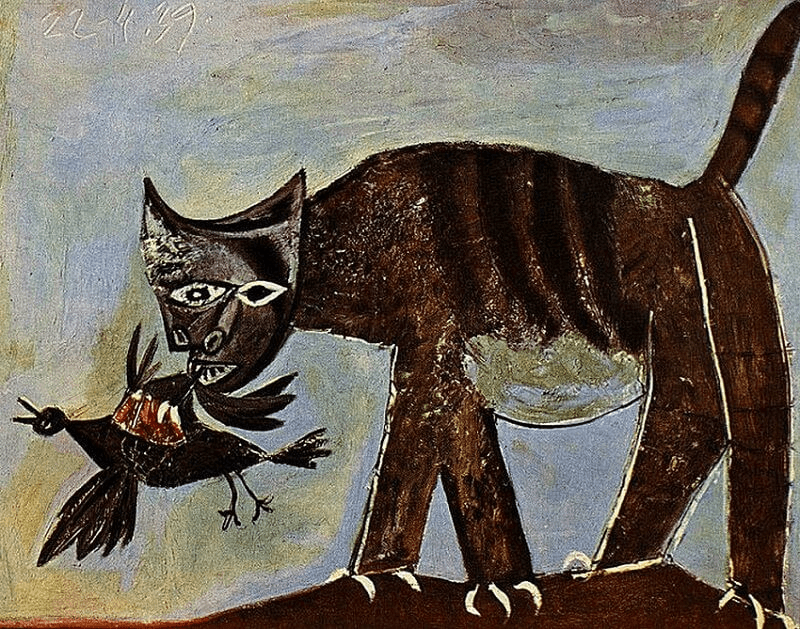
Pierre-Auguste Renoir
Pierre-Auguste Renoir, a master of Impressionism, often painted cats in his portraits, capturing their soft fur and playful personalities with delicate brushwork. Cats in his art were usually shown in relaxed, domestic settings, emphasizing their charm and gentle nature.
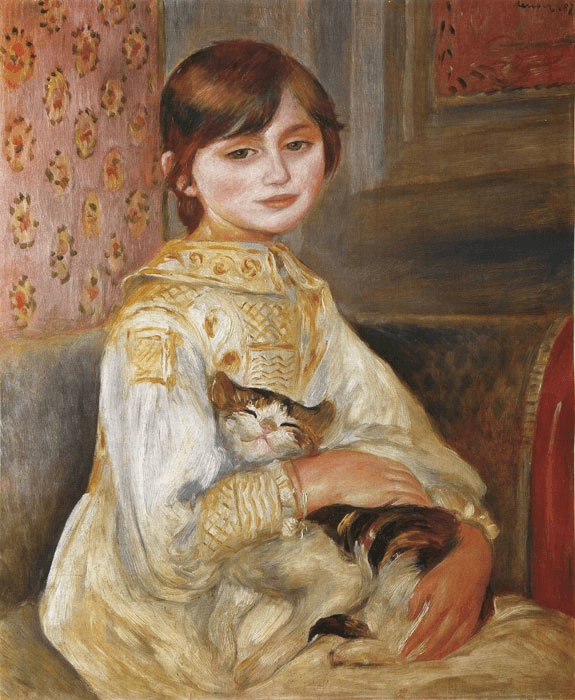
Contemporary Art
- Jeff Koons: Created the humorous sculpture "Cat on a Clothesline," which playfully exaggerates the feline form.
- Andy Warhol: Produced a series of cat-themed works, transforming ordinary cats into pop culture icons with his bold colors and repetitive designs.
- Other Contemporary Artists: Many modern artists continue to find inspiration in cats, exploring themes like the emotional bond between humans and cats or the natural beauty of feline forms in paintings, sculptures, and installations.
Cats remain a timeless muse in art, whether depicted realistically or abstractly. Their elegance, charm, and mysterious nature continue to captivate artists and viewers, ensuring their place in the artistic world for generations to come.
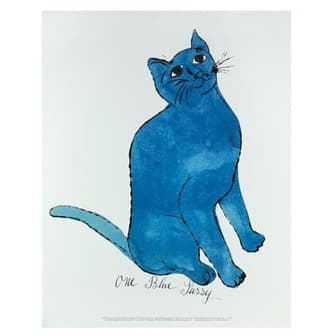
Cats in Pop Culture and Digital Art
Cats have become beloved icons in pop culture, captivating audiences with their humor, mystery, and charm. Their presence has grown from traditional media like film and television to viral internet memes and digital art, making them symbols of joy and creativity across generations.
Cats in Film and Television
Cats have long been favorites in film and television, bringing humor, emotion, and personality to the screen. From animated classics to live-action adventures, they have become unforgettable characters that entertain audiences of all ages.
Animated Classics
- Felix the Cat: One of the first cartoon stars, known for his mischievous antics and bold silhouette.
- Tom and Jerry: The timeless duo featured a crafty cat in endless comedic chases.
- Garfield: A lazy, lasagna-loving cat who became a global pop culture icon.
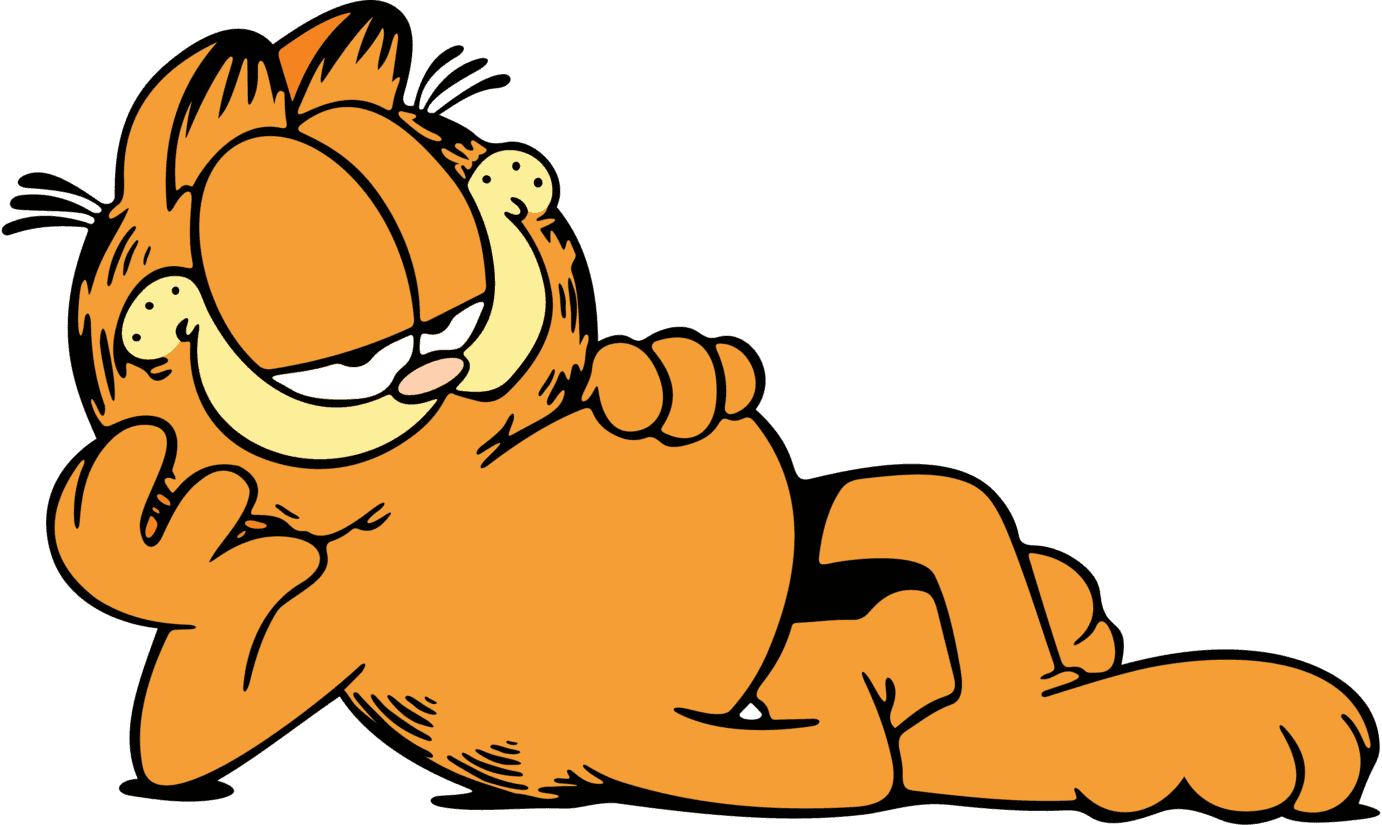
Live-Action Films
- The Aristocats: A Disney adventure about aristocratic cats finding their way home.
- Puss in Boots: The charming feline from the Shrek franchise and his own swashbuckling spin-off.
Television Series
- Sabrina the Teenage Witch: Salem Saberhagen, the sarcastic talking cat, remains unforgettable.
- The Simpsons: Snowball II provided plenty of comedic moments as the family’s pet.
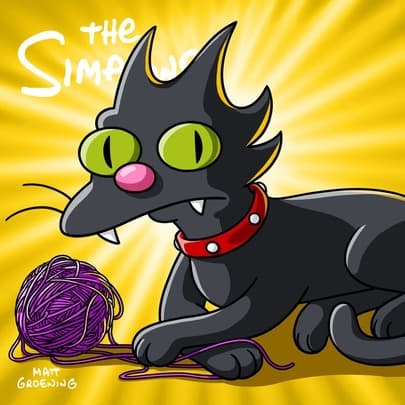
Cats in Internet Culture
The internet has propelled cats to even greater fame, turning them into viral sensations through memes, videos, and social media. Their quirky personalities and funny behaviors have made them internet legends.
- Grumpy Cat: Known for her perpetually grumpy face, she became a viral sensation and inspired memes and merchandise.
- Lil Bub: A sweet, unique-looking cat who won hearts with her gentle personality.
- Nyan Cat: The iconic Pop-Tart-bodied cat flying through space to a catchy tune.
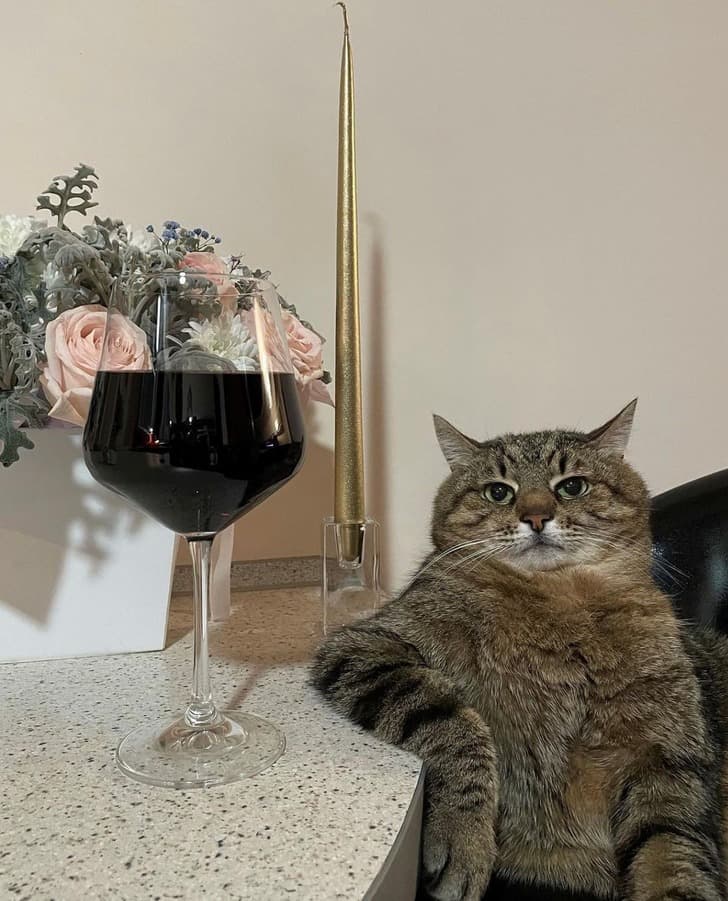
Cats in Digital Art and Gaming
In the digital world, cats continue to inspire creativity in art and gaming. Artists and developers have embraced their elegance and playful nature, showcasing them in innovative and engaging ways.
- Digital Art: Artists use cats in creative digital works, exploring their beauty and grace through modern techniques.
- Video Games: In the digital world, cats continue to inspire creativity in art and gaming. Artists and developers have embraced their elegance and playful nature, showcasing them in innovative ways. In video games, cats have taken on diverse roles, such as the protagonist in Stray, a heroic adventurer in Cat Quest, a collectible companion in Neko Atsume, a guide in Persona 5, and a tameable pet in Minecraft.
Cats continue to inspire artists, filmmakers, and internet users alike. Their enduring popularity shows how they bring laughter, creativity, and connection to people of all ages, cementing their place as timeless cultural icons.
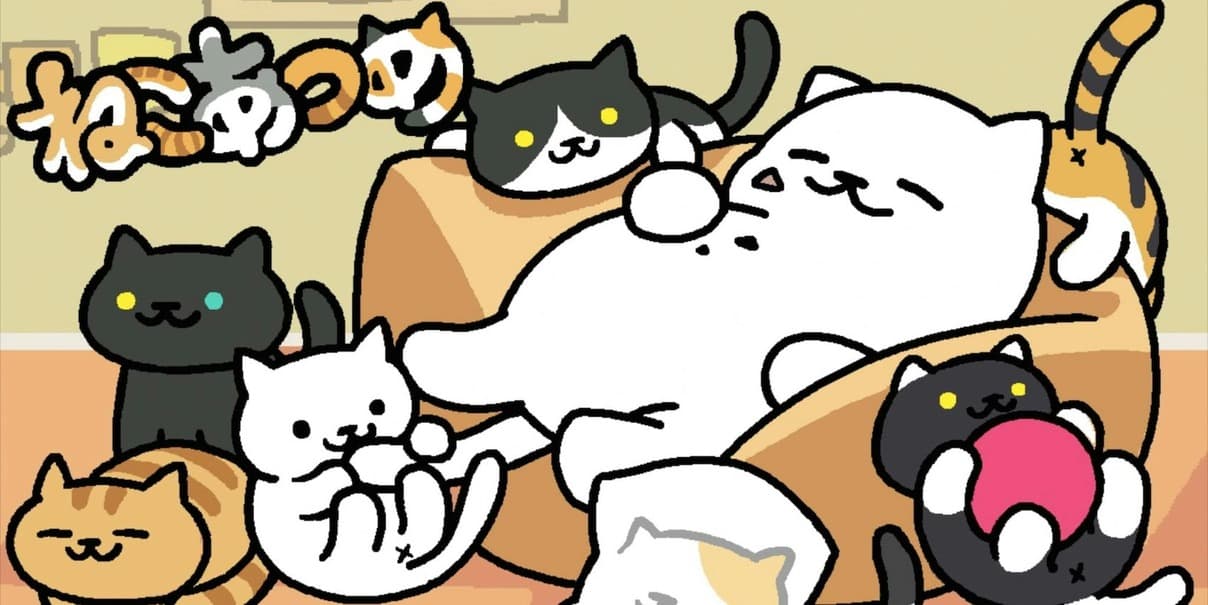
The Enduring Popularity of Cat Art
Cats have inspired art for hundreds of years, capturing people’s attention with their charm, beauty, and unique personalities. Their mix of mystery and playfulness makes them fascinating subjects, while their graceful movements and elegant forms are admired across cultures and eras. Artists have always been drawn to the way cats combine independence with affection, making them both intriguing and relatable.
In history, cats were symbols of luck, protection, and wisdom. Myths and stories from different cultures often described them as magical or spiritual animals, adding to their appeal. Artists loved their sleek fur, expressive eyes, and the wide range of emotions they show, like curiosity, calmness, or playfulness. These traits made cats perfect for both realistic and creative interpretations.
Today, cats are more popular than ever thanks to the internet. Viral videos, funny memes, and digital art showcase their charm and make them icons of modern culture. Whether in old paintings, modern digital creations, or even humorous memes, cats continue to inspire artists and bring joy to people all over the world. Their timeless appeal proves why they remain one of the most celebrated animals in art.
Notable Exhibitions and Collections of Cat Art
Cats have long been celebrated in the art world, inspiring exhibitions, collections, and books that highlight their enduring charm and cultural significance. Here are some of the most notable showcases of cat-themed art.
Famous Exhibitions
The Musée d'Orsay in Paris hosted the exhibition "Accro-chat-ge," which brought together a stunning collection of cat-themed art. The display featured works by renowned artists such as Édouard Manet and Théophile-Alexandre Steinlen, alongside contemporary creators like Françoise Pétrovitch. The exhibition celebrated the artistic portrayal of cats, spanning classic 19th-century pieces to modern interpretations.
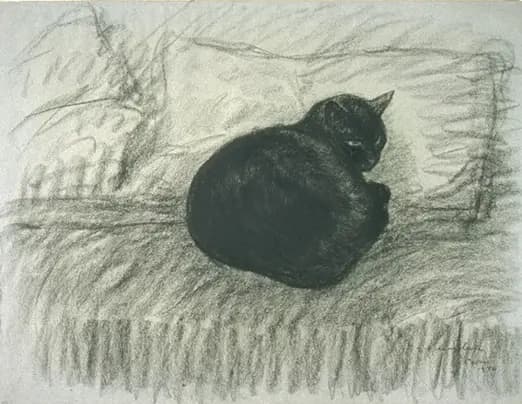
Books Featuring Cat Art
Cats have also been celebrated in numerous books that explore their artistic legacy. Books by Louis Wain compile his imaginative, playful, and anthropomorphic cat paintings, showcasing his unique style. Many general art books also feature dedicated sections on cat-themed art, examining its history, highlighting famous artists, and exploring the diversity of styles and techniques that have captured the essence of cats in art.
From exhibitions to collections and books, cat art continues to captivate audiences and celebrate the timeless relationship between humans and their feline companions.
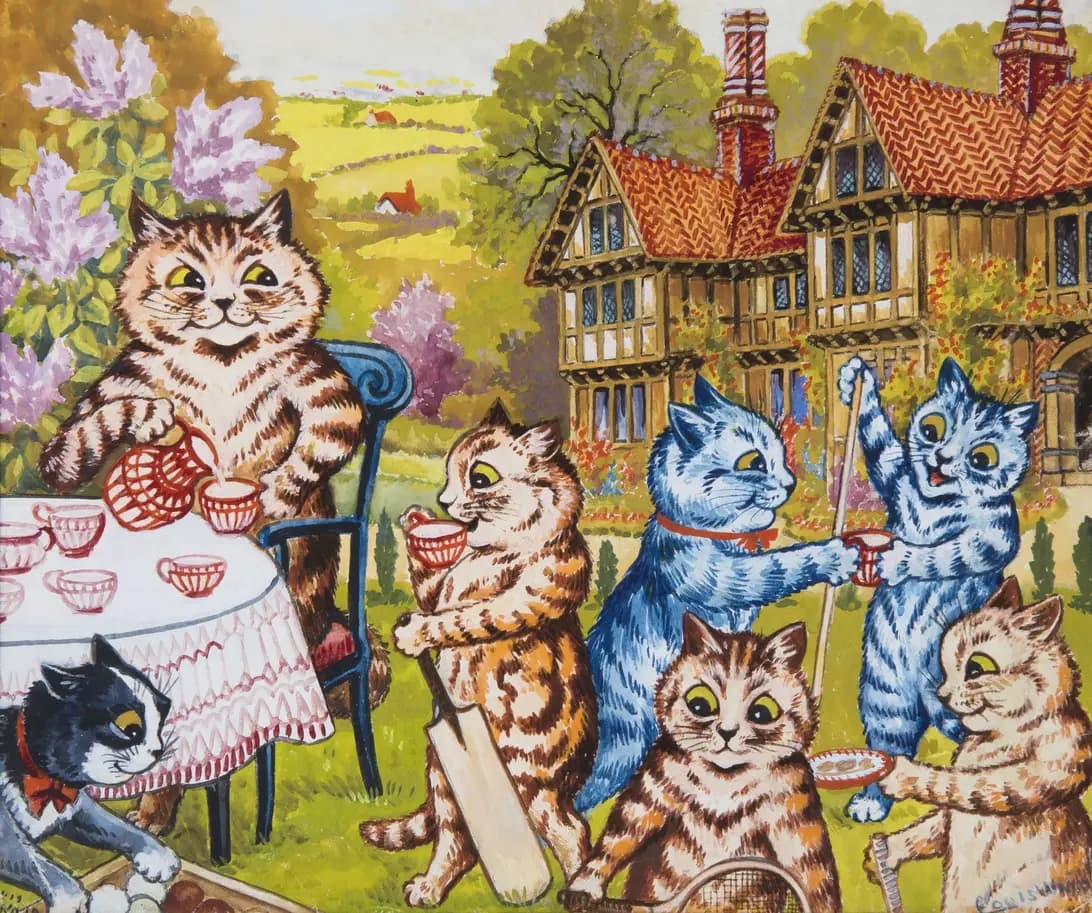
How to Turn Your Cat’s Picture Into a Painting
Turning a picture of your cat into a painting is a wonderful way to honor their unique personality. From their soft fur to their playful eyes or cheeky expressions, a custom painting can bring their spirit to life and preserve it forever. With the right photo and medium, you can create a piece of art that truly captures the bond you share with your furry friend.
- Choosing the Right Medium: Different paints create different styles. Oil paint is great for detailed fur and rich colors. Watercolors create a soft and gentle look. Acrylics are bold and colorful, making the painting stand out, while digital art is perfect for quick, custom designs with lots of flexibility.
- Selecting the Best Photo: Pick a clear, well-lit photo of your cat. Natural light shows details like fur patterns, eye color, and facial expressions best. Choose a picture that shows your cat’s personality, whether they are playful, curious, or relaxed.
- Finding Inspiration: If you have more than one cat, artists can combine photos into one painting. This lets all your cats be in the same artwork, even if they couldn’t pose together.
With the right photo and medium, a custom cat painting becomes more than just art. It’s a lasting tribute to the bond you share with your furry companion.
Conclusion
A custom cat painting is more than just a piece of art—it’s a heartfelt way to celebrate the special bond you share with your feline companion. Whether you choose a timeless traditional painting or a modern digital artwork, the result is a meaningful keepsake that captures your cat’s unique personality and adds a personal touch to your home. With the right artist and style, your cat’s portrait can become a cherished treasure, reminding you of their love and companionship for years to come.
At Photo2Painting, we love cats and specialize in turning your favorite feline moments into custom art that lasts a lifetime.
Frequently Asked Questions
Who is the cat obsessed artist?
Louis Wain, a British artist, is known for his whimsical and anthropomorphic cat paintings. His unique style captured the personality and charm of cats, making him an iconic figure in feline art.
Who is the famous modern cat artist?
Françoise Pétrovitch is a notable contemporary artist who features cats in her work. Her art often explores themes of domesticity and the human-animal bond, with cats depicted in a surreal and expressive style.
What is the famous painting of three cats?
“The Three Graces" by Rembrandt van Rijn features three young women, each with a cat on their lap. The cats symbolize grace, charm, and beauty, aligning with the themes of the painting.
Who was the Dutch painter of the cat family?
Gabriel Metsu, a 17th-century Dutch painter, often included cats in his genre paintings. His works highlight domestic life and the close bond between humans and cats.
Who is the artist known for drawing cats?
Louis Wain is the most famous artist for drawing cats. His imaginative and distinctive style made his depictions of felines both beloved and iconic.
Did Rembrandt paint a cat?
Yes, Rembrandt painted a cat in his artwork "The Three Graces," which features three young women, each accompanied by a cat on their lap.
Which English Artist was known for cats?
Louis Wain is the most famous English artist associated with cats. His vibrant and imaginative cat paintings have left a lasting legacy in the art world.
How much was the most expensive cat painting ever sold?
While there isn't a specific record of the most expensive cat painting ever sold, works by renowned artists like Louis Wain can fetch significant prices at auctions.
Did Vincent Van Gogh paint any cats?
No, Vincent van Gogh did not paint any cats. There are no records or known artworks by Van Gogh that include cats as a subject.
George, CEO of Photo2painting, is a passionate art lover and entrepreneur. He founded Photo2painting.com from scratch, inspired by his artist friends. As the company's CMO, he manages content and marketing.
Excellent Customer Reviews















































































































































